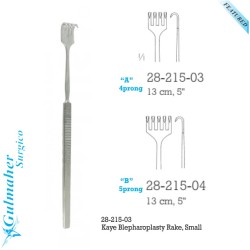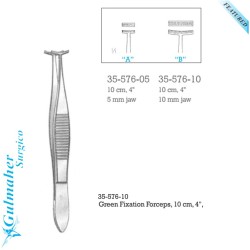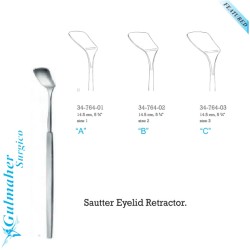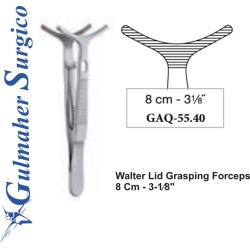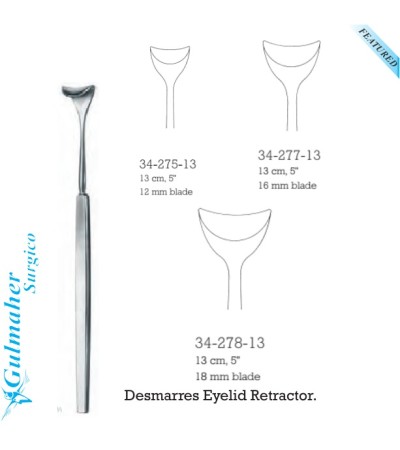
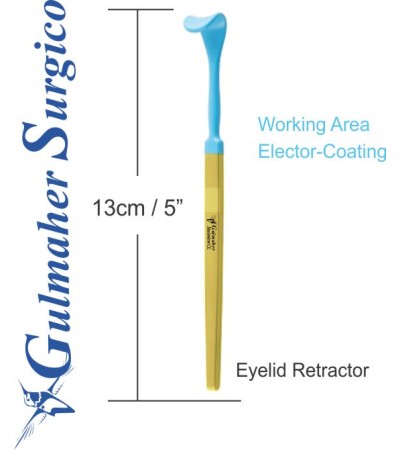
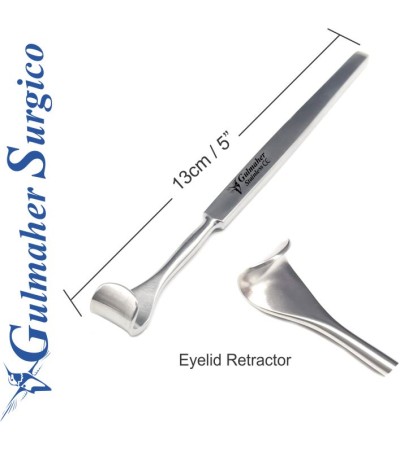



Desmarres Eyelid Retractor 13cm - 5"
$8.00
- Stock: In Stock
- Article #: 34-275-13
Available Options
The eyelid retractor is a surgical instrument specifically designed to hold the eyelids open during ophthalmic or blepharoplasty surgery procedures. It is a thin blade and has commonly three working width sizes, 12mm, 16mm, and 18mm wide. Buy online Blepharoplasty - ophthalmic Surgery Instrument Sets having a tentative collection of tools. Here are some key points about its use:
Purpose:
- Exposure: The eyelid retractor allows for better visibility and access to the eye by keeping the eyelids apart, which is crucial during surgeries such as cataract removal, eyelid repair, or other ocular procedures.
- Stability: It helps maintain a stable field of view, allowing the surgeon to operate with precision without needing to rely on assistance to hold the eyelids open.
Design:
- Types: There are various types of eyelid retractors, including the Desmarres retractor and the Barraquer retractor, each designed for specific surgical needs.
- Shape and Size: Eyelid retractors typically have a flat, curved design that conforms to the eyelid's anatomy, and they come in different sizes to accommodate various patient anatomies.
Considerations:
- Tissue Protection: Care should be taken to avoid excessive pressure on the eyelids and surrounding tissues to minimize trauma and discomfort.
- Sterilization: As with all surgical instruments, proper sterilization before and after use is essential to prevent infection.
- Material: Stainless Steel
- Finish: Satin
- Packing: Plain / Pouch / Kits
- Sterility: Non Sterile
If you have any specific questions about eyelid retractors or their applications, feel free to ask!
- Sterilization: Surgical instruments may be steam autoclaved at a temperature of 121°C (250°F) for 30 minutes or flash autoclaved at a temperature of 127° to 132°C (260° to 270°F) for 10 minutes.
- Recommended Sterilization Parameters: PRE-VAC Unwrapped Goods Cycle 5 minutes at 132° C/270° F. Dry Time: none recommended.
Wrapped Goods Cycle 5 minutes @ 132° C/270° F Dry Time: 5‐20 minutes*
- Recommended Gravity. Unwrapped Goods Cycle 10 minutes @ 132° C/270° F Dry time: none recommended. Wrapped Goods Cycle 30 Minutes @ 132° C/270° F Dry Time: per facility recommendation. Wrapped Goods Cycle 60 Minutes @ 132° C/270° F Dry Time: per facility recommendation. *Depending on Hospital Protocol* Warning: Flash sterilization is not the recommended sterilization method. All surgical instruments and parts should be steam autoclaved when time permits. However, flash sterilization may be used when there is an immediate need for an instrument, injector, or accessory and there is no other alternative.
- Aeration: As required to return to room temperature or to start the next cycle.
- Contraindication: Hospital policy and procedure(s) take precedence over this protocol. Failure to use approved cleaning and sterilization procedures may void the warranty.
- Cleaning Instructions: Cleaning: All instruments must be cleaned to remove contaminated substances before sterilization. After each use, perform an initial cleaning within the sterile field by wiping the tool or instrument free of blood and body fluids. Then clean the instrument thoroughly with a mild soapy solution. Do not use alkaline-based cleaners. Complete preparation for sterilization by hospital procedure using an approved cleaning agent. Do not run any type of abrasive materials or steel brushes through the lumen of the tool. The abrasive material can score the inside of the tool, rendering them inefficient. After flushing, the instrument needs to be well-rinsed with warm to hot water. Visually inspect each instrument to ensure all fatty deposits are removed. All instruments should be cleaned and rinsed with mild, non-abrasive, grease-removing cleaners before they are sterilized. Gulmaher Instruments recommends that during the cleaning and rinsing procedures, all instruments should be inspected. Ultrasonic cleaning after manual cleaning is recommended.
Tags:
Eyelid retractor
, Ophthalmology Retractor
, Upper eyelid Retractor
, Lower Eyelid Retractor
, Blepharoplasty Retractor
You May Like
Cope Retractor, 18cm, D/E, 10x13mm, 20x6mm
Material:
Stainless Steel
Finish:
Satin
Packing:
Plain / Pouch / Kits
..
$10.00
Kaye Blepharoplasty Rake|eyelid surgery instruments|
Material: Stainless Steel
Finish: Satin
Packing: Plain / Pouch / Kits
..
$9.00
Green Fixation
Forceps, 10 cm, 4", 10 mm Jaw| blepharoplasty eyelid surgery instruments
Material: Stainless Steel
Finish: Satin
..
$14.00
Sautter Eyelid Retractor - Blepharoplasty eyelid surgery instruments
Material:
Stainless Steel
Finish:
Satin
Packing:..
$10.00
Walter Lid Grasping Forceps 8 Cm - 3-1⁄8"..
$9.50
A Cushing or vein retractor is a type of surgical instrument which is utilized to isolate the edges of a cut or can keep down hidden organs and tissue..
$15.00


